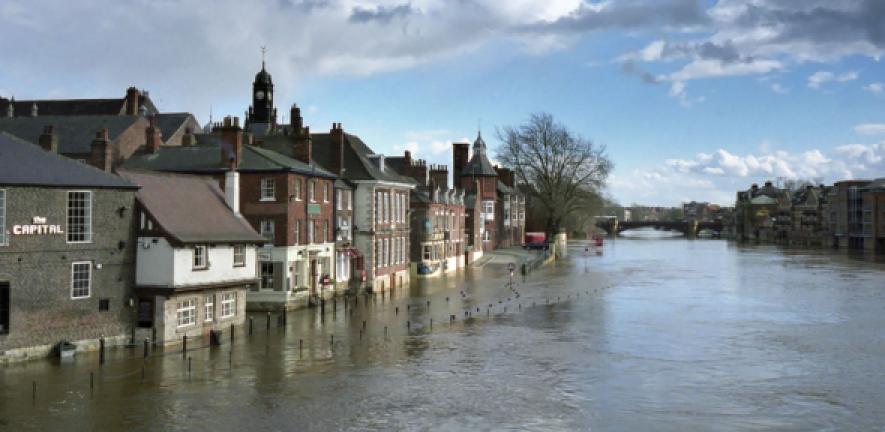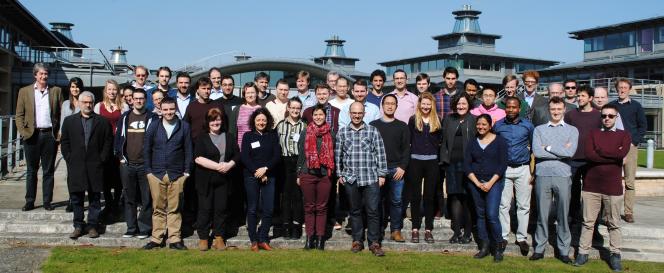
Isaac Newton Institute

Background
In partnership with Maths Foresees, an EPSRC network funded under the Living With Environmental Change (LWEC) umbrella, the TGM hosted the second Environmental Modelling in Industry study group. The event followed a successful first study group held in September 2015 where potential solutions to five industry challenges were explored.
Maths Foresees aims to forge strong ties between researchers in the applied mathematics and environmental science communities and end-users of environmental research. Through a series of activities the network helps to facilitate active knowledge exchange between these groups and to rethink the approach to the prediction, analysis and mitigation of extreme environmental events.
Aims and Objectives
The analysis of extreme environmental events and natural hazards poses a number of significant challenges. To help address these challenges, it is crucial that mathematicians with the relevant expertise interact closely with environmental scientists and end-users of environmental research. This study group aimed to bring together researchers working in relevant areas of the mathematical and environmental sciences with end-users of environmental research to develop innovative solutions and insights relevant to industry.
The event followed the format of standard mathematics-with-industry study groups. It opened with the presentation of the proposed industrial challenges, followed by the main study group sessions, and cumulate in the presentation of the solutions explored.
Challenges
Over the course of four days, delegates explored one or more challenges posed by companies operating in the environmental sector. This intensive period of collaboration between mathematicians and environmental scientists provided a fantastic opportunity to develop solutions to problems arising in industry.
Descriptions of the challenges are as follows:
Estimating Flood Probability Using Historical Data (Environment Agency)
Understanding the chance that a property will flood is fundamental for deciding which projects get funded. Usually we use flood models to estimate flood probabilities. But models are expensive to build, making some small projects prohibitively expensive. Could we use statistics instead, to get an answer that is good enough? If a property has flooded 30 times in 30 years then we could be confident that that property is at risk of flooding. Even without building a model. But what about if the property had flooded 5 times in 10 years? Or 3 times in 5 years? We are looking for a tool that takes data on flood events over a period of time. In return it estimates which of five probability bands the property falls in to, along with an estimate of confidence.
More information is in the Challenge document.
Since the workshop, the report prepared by those working on this Environment Agency challenge has been peer reviewed and revised.
Making Decisions Using Uncertain Forecasts (Environment Agency)
Probabilistic forecasting has become a standard part of our flood warning system over the last ten years. The new challenge is in turning mid to low certainty forecasts in to action. It requires an understanding of the costs of acting and not acting when the flood occurs and doesn’t occur. For example, say there is a 20% chance of a town flooding. We could evacuate the town but this has an operational costs as well as posing risks to the people involved. If the flood doesn’t happen then the evacuation would have been needless. But if we don’t evacuate and the town does flood then there would be a catastrophic loss of life. Initially we are looking for a way of solving a simple binary decision with a single forecast. The next step is to expand this to non-binary decisions. For example: “evacuate”, “don’t evacuate” or “wait until the forecast is more certain”.
More information is in the Challenge document.
Since the workshop, the report prepared by those working on this Environment Agency challenge has been peer reviewed and revised.
Understanding Rainfall Patterns (Environment Agency)
Most rainfall dependent flood models are built with the assumption of a single design event. Essentially this means that the same rain falls everywhere at the same time. We know that’s not how rain falls in real life and so we could be leading to over or underestimates of flood risk in some areas. There are methods that exist that can model non-uniform rainfall. They include Monte Carlo simulation and continuous simulation. The problem with these is that they are expensive requiring many more model simulations than a single design event. Could importance sampling techniques be used to reduce the number of model simulations required?
More information is in the Challenge document.
Since the workshop, the report prepared by those working on this Environment Agency challenge has been peer reviewed and revised. An interim final report is now available.
Modelling Sewer Networks (Sweco)
Water companies maintain large 1D sewer network models. These 1D networks are utilised by councils to discharge their statutory responsibilities with regard to flooding, usually to an engineering consultancy. The 1D models are generally composed of manholes and conduits that represent the conveyance part of the network; the collection network (gullies and so on) is not typically represented.
When the 1D models are adapted to be used in 1D/2D several issues can cause inaccurate flood extents:
- surface water is collected by, and issued from, manholes rather than the collection network;
- collection and flooding occur at the wrong locations;
- not enough water is collected – (1) manholes become inlet-limited particularly for short sharp rainfall, and (2) the storage attributed to the collection network is not accounted for; and
- surface water pools indefinitely rather than charging the network during the recession of a storm.
The obvious solution is to just build the collection network. However, this is prohibitively laborious and expensive. Potential solutions include (1) an automated system that assimilates information from topographic, network and GIS data to create a physical representation of a collection network; (2) an automated system that assimilates topographic, network and GIS data to create road ‘collection subcatchments’ to model the effect of the collection network or (3) something else.
More information is in the Challenge document.
Since the workshop, the report prepared by those working on the Sweco challenge has been peer reviewed and revised.
A Risk-based Analysis of Small Scale, Distributed, “Nature-based” Flood Risk Management Measures Deployed on River Networks (JBA Trust)
There is growing interest in the use of “nature-based” flood risk management measures, which include small-scale runoff attenuation features (RAFs), typically “leaky” dams or barriers made from wood that allow low flows to pass through, but that hold back high flows, thus providing temporary storage of flood water. The hope is that a large collection of such RAFs deployed in small stream channels may hold back enough flood water so as to mitigate flood risk downstream, where communities and people are at risk.
This Challenge seeks to understand the performance and optimisation of a system comprising a collection of individual RAFs, distributed spatially throughout a connected stream network in a river catchment.
More information is in the Challenge document.
Since the workshop, the report prepared by those working on the JBA Trust challenge has been peer reviewed and revised.
Registration and Venue
The workshop took place at the Isaac Newton Institute for Mathematical Sciences in Cambridge. Overnight accommodation was reserved at Murray Edwards College. Meals, accommodation and reasonable transport costs within the UK were covered by the Maths Foresees network.
The event started at 9am on Monday 3rd April 2017 and closed with lunch on Thursday 6th April 2017.
College Dinner Monday 3rd April 2017
A dinner took place at St John's College on Monday 3rd April.






